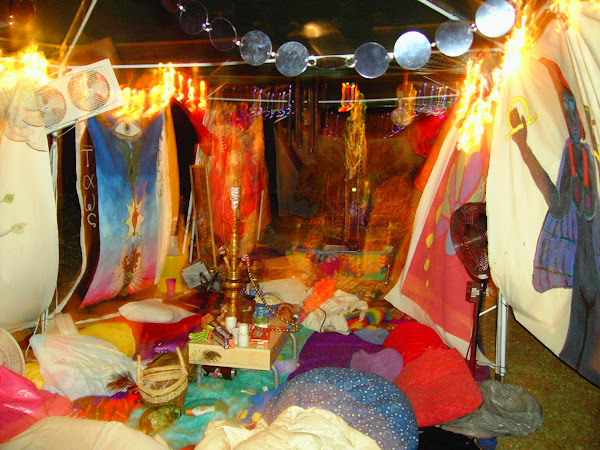Against the Day is unlike any other book I have ever read, and one that defies review. Thomas Pynchon’s latest epic tips the scales, packed with 1,086 pages of wonderful characters, marvels, and a tapestry of themes. Ostensibly a novel of revenge, AtD is also (among many other things) an extended rumination on various kinds of light, from the mundane to the esoteric. As the title implies, this is no glorification of spiritual Illuminism so much as a cautionary tale about excesses of light set against the consolations of night.
Taking place in the years prior to World War I, depicted as a sort of historical tipping point here, AtD explores many fascinating themes: Orphism, anarchism, espionage, the elusive nature of freedom, Utopian dreams, Shambala, secret societies, Tarahumara shamanism, peyote visions, doppelgangers, sexual escapades, emergent plutocracy, time travel, the 4th dimension, Icelandic spar, intelligent dogs, Gnostic inversions, Tarot trumps, super-weapons, Lovecraftian monstrosity, Bogomils, hollow Earth theories, Nicolai Tesla, Central Asia, the set of all sets that have themselves as a member, rembetica, fezzes, ukeleles…
The novel begins with the Chicago Exposition of 1893, and some of the best and funniest writing is devoted to this event. Here we first become aware that although this is a book that begins more than a century ago, it sheds a lot of light on our contemporary world and its problems. Much of Against the Day follows the lives of the Traverse family and their acquaintances. Webb Traverse, the patriarch, is an anarchist dynamiter who is done in by hired guns working for the mining company, the owner of which, Scarsdale Vibe, is the novel’s designated vile plutocrat. The task of vengeance falls to Traverse’s three sons, Kit, Reef and Frank. Traverse’s daughter, Lake, marries Deuce Kindred, the man who shot her pa.
This is an incredibly sprawling and tempestuous read. Erudite passages collide with goofy gags, spontaneous musical numbers and puns. Woven throughout the pages is a hilarious parody of juvenile adventure novels and pulps featuring a zeppelin crew of boy adventurers, the Chums of Chance, inspired by the likes of Tom Swift and Doc Savage. Theosophy is also lampooned as T.W.I.T., the True Worshippers of the Ineffable Tetractys. Then there are the Visitors, who come from the future or possibly another dimension. “They have been crossing here, crossing over, between the worlds, for generations. Our ancestors knew them. Looking back over a thousand years, here is a time when their trespassings onto our shores at last converge, as in a vanishing-point, with those of the first Norse visitors.”
I will admit to my share of bafflement at much of the math, and confusion generated by a multitude of characters that pop in and out of the narrative like prairie dogs. In the beginning, I leaned heavily on the in-progress Pynchon wiki to help decode obscure historical references, foreign phrases and greater context. But in the last few hundred pages, I surrendered to the flow which carried me hither and yon beyond my wildest expectations.
One of the interesting things about finishing this book is rereading reviews of it. It seems that more than a few reviewers didn’t finish reading it and covered their retreats with bluster. One or two actually admit to skimming. Malcolm Jones of Newsweek arguably takes the best approach and serializes his review in an attempt to keep pace with the novel:
http://www.msnbc.msn.com/id/15771953/site/newsweek/
Having lived with this book for three months, I can’t imagine reading it on a deadline. It’s accessible even if one doesn’t run all of the references to ground, but I would recommend savoring it and doing a little bit of reference legwork. If it touches on a subject you happen to relish, you will find plenty of delightful in-jokes and references. But even without a compass, you can appreciate this wild and wide-ranging ride, by turns hilarious and horrifying, intimate and cosmic.
For those interested in Pynchon’s meta-fictional innovations, a running theme of doubling is woven through the book, along with the material symbol of doubling, Icelandic spar, which acts as a sort of mystical lens. Toward the end of the novel, the narrative splits off into an alternate fictional “reality,” one in which we discover the destinies of the major characters as they unfold there. Even in this alternate reality, one character makes an escape into yet another reality, where he is informed that he just returned from Shambala. Fans of the many worlds interpretation of quantum physics will find much to enjoy here.
As long as Against the Day is, I didn’t find myself wanting to skim pages or eager for it to be over. I savored the experience to the very last page, enjoying Pynchon’s ability to conjure so much in this play of light and darkness. Ultimately, the experience of reading becomes lysergic, phantasmagorical and transcendental. The novel, like Biblical Leviathan, swallows you whole and spits you out, exhausted but happy to be alive, on some strange beach.


1 comment:
Well put. I'm reading Against the Day right now and finding extremely interesting. Sometimes I just wanna spend all day immersed in its zaniness.
Post a Comment